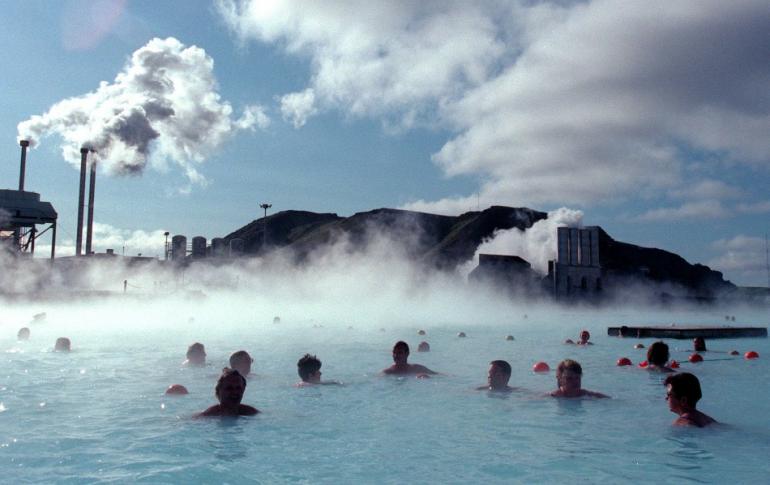
Geothermal power facilities generate 25% of Iceland’s total electricity production. About 84% of Iceland’s energy use comes from renewable resources and 66% of that was geothermal. Iceland’s energy supply uses only 1% from fossil fuels, making the country extremely environmentally efficient. One example of geothermal energy are underground reservoirs of steam and hot water used to generate electricity.
To produce geothermal-generated electricity, underground wells that extend to nearly a mile deep or more are drilled into the reservoirs to tap steam and hot water that drive turbines linked to electricity generators
This video is from someone’s visit to the hot spring known as the “Blue Lagoon.” http://www.youtube.com/watch?v=NTNh-PHj6vc

Volcanoes also are used in geothermal production in Iceland. Because there are over 200 volcanoes across the country, high-temperature areas containing steam fields with underground temperatures reaching 250°C within 1,000 m depth can be used to also generate electricity.

The largest geothermal power station in the world is . It has the capacity to produce 303 MW of electricity and 400 MW of hot water. It uses turbines and a low pressure steam to extract thermal energy through pressurized steam.
One of the biggest advantages that Iceland has taken advantage of is that geothermal energy can be produced without burning fossil fuels such as coal, gas, or oil. The fields produce only about 1/6 of the carbon dioxide that a clean natural-gas-fueled power plant produces. Also, geothermal energy can be produced any time of year as opposed to solar and wind energy.
Resources:
1. http://www.nea.is/geothermal/
2. http://www.nea.is/geothermal/the-resource/
3. http://environment.nationalgeographic.com/environment/global-warming/geothermal-profile/
4. http://www.scientificamerican.com/article/iceland-geothermal-power/
5. http://www.icelandgeothermal.is/
 The Stirling Heat Engine uses internal-combustion for power invented by Scottish inventor Rev. Robert Sterling in 1816. Today, it uses the Stirling cycle to power vehicles such as submarines and auxiliary power generators for yachts.
The Stirling Heat Engine uses internal-combustion for power invented by Scottish inventor Rev. Robert Sterling in 1816. Today, it uses the Stirling cycle to power vehicles such as submarines and auxiliary power generators for yachts.
- The gasses inside the engine never leave the engine which means there are no explosions taking place. The Stirling cycle uses an outside heat source such as gasoline tor solar energy to the heat. Because of this, it is more efficient than diesel and gasoline engines.
Here is a link that I found helpful as to the process of the Stirling cycle. http://www.youtube.com/watch?v=rym_LB9tIi8
Though these engines are extremely efficient, they still are not used in cars yet. For one, it takes some time for the cycle to begin and gain the speed necessary to move a car. In the past, automotive companies such as Ford, GM, and American Motors Corp. have invested in the development of these engines, but unfortunately nothing was ever made for mass production. It is possible that these engines may be used for conventional purposes, but for now it is mainly applied to Stirling machines.
The Peltier Device is a thermoelectric heat pump that transfers heat from one side of the device to the other. If electric energy is applied, one side will heat up the other one will get cold and if heat is applied on one side and cold to the other side, electric energy will be generated.
Reversing the applied current’s polarity causes the temperatures will also reverse.

This video was really helpful for me to understand the reversed polarities.
https://tetech.com/peltier-thermoelectric-cooler-modules/
The Peltier Device is typically used commercially in portable coolers and cooling electronic devices and small instruments. The cooling effect of Peltier heat pumps can also be used to extract water from the air in dehumidifiers.
Resources:
1. http://auto.howstuffworks.com/stirling-engine.htm
2. http://en.wikipedia.org/wiki/Stirling_engine#History
3. http://www.stirlingengine.com/faq/
4. https://tetech.com/peltier-thermoelectric-cooler-modules/




